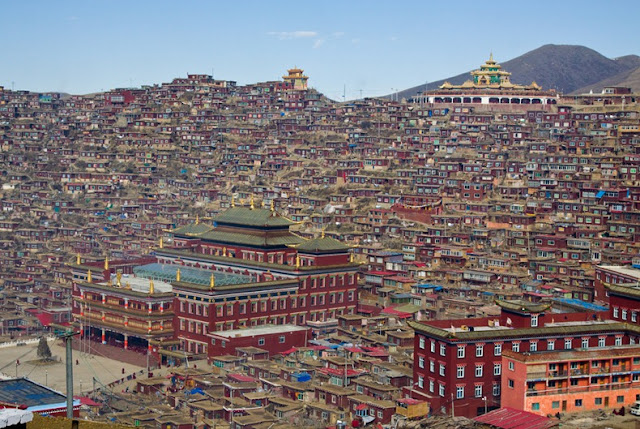In 1980, Khenpo Jigme Phuntsok founded Serthar Institute, known as Larung Gar Buddhist Academy, in the Larung Valley near the town of Serthar, Karze Prefecture, Sichuan Province. The purpose of the Institute has been to provide an ecumenical training in Tibetan Buddhism and to meet the need for renewal of meditation and scholarship all over Tibet.
Despite its remote location, it grew from a handful of disciples gathering in Khenpoâs home to be one of the largest and most influential centers for the study of Tibetan Buddhism in the world, numbering to nearly 10,000 monks, nuns, and lay disciples by the year 2000.
Overall, the student body of Serthar Institute was made up of monks, nuns, lay "vow-holders" of both Tibetan and Chinese origins, and tantric practitioners. They studied under four major religious divisions in the Institute: Ngarig Nangten Lobling, International Religious Committee, Pema Khandro Duling Nunnery, and Lektso Charbeb Ling. Ngarig Nangten Lobling consisted of 2,500 Tibetan monks. Lektso Charbeb Ling is the section that trained over 1,000 lay Tibetan "vow-holders" and tantric practitioners from Serthar and other regions of Tibet.
Pema Khandro Duling Nunnery was the home for study to approximately 3,500-4,000 nuns from all regions of Tibet. More than half of those who came to Serthar were women and the curriculum allowed nuns to achieve a coveted Khenpo degree for the first time in Tibetan history. Entry into the relatively small number of nunneries that exist in other areas of Tibet is limited, but Serthar was open to virtually anyone who genuinely sought to become a student of Khenpo Jigme Phuntsokâs ecumenical vision. Khenpoâs niece, Jetsunma Mumso, was recognized as a tulku, which means, literally, âemanation bodyâ (sprul-sku). She heads the order of nuns. The term is descriptive of certain teachers in Tibet who are thought to reincarnate over a number of generations.
Roughly ten percent of the nearly 10,000 students attending Serthar were ethnic Chinese. They attended separate classes taught in Mandarin while larger classes were taught in the Tibetan language. The International Religious Committee oversaw 1,000 disciples from regions of the Peopleâs Republic of China and students from other Asian countries.
Serthar Institute has operated with a standing executive committee of seven learned lamas, but major decisions were confirmed and implemented only after consultation with Khenpo Jigme Phuntsok. Serthar Institute has been home to over 500 khenposâholders of doctorate degrees in divinityâand widely renowned for the high quality of both its religious and secular education. English, Chinese, and Tibetan languages and modern computer studies have been taught alongside traditional non-sectarian Buddhist curriculum.
Enjoy Reading and Pls Support us by Liking Us on Facebook













